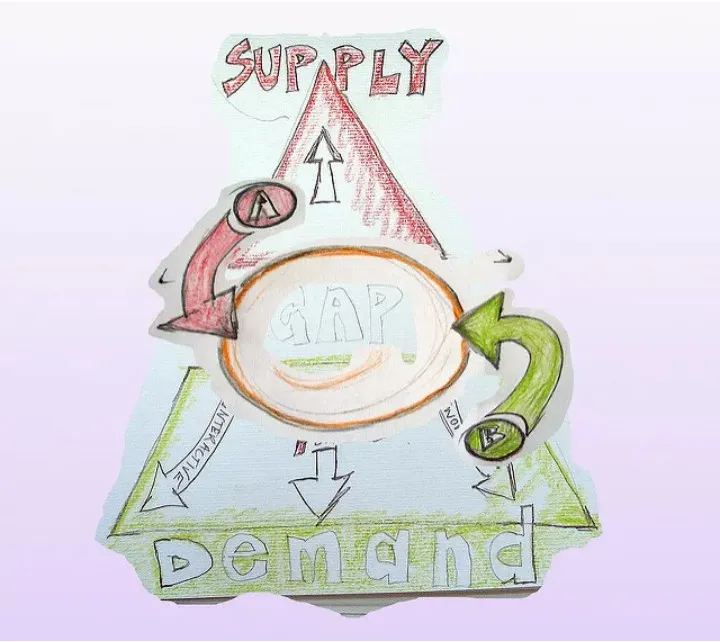In an hypothetical scenario where the supply of STEEM grows by 9% per annum and users in the enclosed ecosystem grows by 200% per annum, the eventuality can be vaguely predicted by the economic law of Demand and Supply. But again, If y'all don't mind😏, I'm going to approach this topic from an engineering perspective because I think I have better analogies in that discipline.

Now let's consider a cylinder of a fixed volume which contains a pure substance of any kind in gaseous phase. According to the kinetic theory of gases, the molecules of this gas are in constant motion, colliding with themselves and the walls of the container. This is what results to pressure on the walls of the container. In a scenario like this, the pressure of the system can be increased in two ways;
- Reduction in the volume of the cylinder, majorly a closed system i.e a system that does not allow an outflow.
- Increase in the cylinder's content, the gas (A net increase of the cylinder also allows outflow of gases i.e an open system).
Both ways results to an increase in the number of collisions between the molecules of the gases themselves and the walls of the container, which is what results to an increase in pressure in the system.
Pressure is considered an intensive property of a thermodynamic system and so is temperature and specific volume. Thermodynamically, properties of a system set the state of that system. Specifically the state postulate specifies that, "The state of a simple compressible system is completely specified by two independent, intensive properties".
A better understanding can be attained, to if one thinks of a blowing air into a balloon. In this case, the pressure on inside the ballon is increased by increasing it's air content. The collisions of the molecules of air with the walls of the balloon material is the cause of this and it consequently results to the size of the balloon. If one checks properly, one would notice that the temperature of the balloons inlet increased and the body too but only slightly. If there is enough pressure increase, the temperature of the body of the balloon would increase more significantly.

A girl increasing the pressure in a balloon by blowing air into it
Image Source - Licensed By
This gives us a rough but valuable understanding that there is a relationship between properties of a system. This is true and in fact, at a given state, the properties of a system has a fixed value. Considering an ideal state, they are related by the equation of state, given by;
Where P is Pressure.
v is Specific Volume.
R is Gas Constant (specifies nature of gas).
T is Temperature.
From the above equation, with proper observation it can be seen that an increase in pressure results to a decrease in specific volume and an increase in temperature. In single phases, these properties can be independent, that is, two others can be varied while keeping one of them constant by some engineering design. For example, reducing pressure by increasing the size of a gas container should make the gas colder, but placing it on a hot plate, helps maintain the temperature.
I know you might be asking, how does all these thermodynamic jargons relate to the STEEM ecosystem?.😂🤣
Now that you've been basically grounded in the aspect of thermodynamics that relates these, I'll tell you.😏

Image Source
Image Credit
First of all, you must realise that the STEEM ecosystem is a system itself and it's boundaries are set by the STEEM token because this is what powers the Blockchain. The users are modelled as the gas molecules. Again for simplicity, we'll consider a scenario where every user has an equal influence (STEEM Power) in the ecosystem. This helps us fit the model to truth that gas molecules are exactly the same.
The increase in of gas molecules (users) and without an equivalent increase of the system's boundaries (supply of STEEM) results to more collisions between the molecules of these "gas molecules" and the walls of the container. These collisions can be seen economically as demands. As explained above, these collisions results to an increase in pressure on the boundaries of the container and if the equation of state formulated above governs this "modelled thermodynamic system" as well, it should result to an increase in temperature of the gas molecules. When these gas molecules come in contact with the boundaries of the container, they attain thermal equilibrium (equalling temperature of the gas molecules and the wall) after some time, resulting to an increase in temperature of the wall or boundaries of the container as well. Also these collisions results to a strain on the boundary molecules, increasing their energy as well, just as a strain on water molecules through the addition of heat results to a more energetic gaseous molecules.
The increase temperature of the gas molecules and the walls of the container (plus container molecules strain) would translate to economically mean increase in utilization of STEEM and an increase in the price of STEEM respectively which is in line with what the law of Demand and Supply would predict.
One must not forget or neglect the assumptions made subliminally. They include;
• That the molecules of gases are the same meaning which translates to mean that all users would have equal STEEM Power. Bigger Molecules would mean users with higher STEEM power. This can be usually resolve with the Theory of Gas mixtures.
• The Molecules of Gases do not react with each other on collisions, they merely rebound like elastic balls with kinetic energy conserved. This makes sense because interactions between users are trustless, hence there would be no conflict in the Ecosystem.
• Negligible intermolecular forces between molecules. The translation of this would mean the decisions of user accounts are independent of each other. Hence negligible amount of multiple accounts by one user.
The consideration of the above assumptions has led to the formulations of better equations of states that increases the accuracy of results.
Hence, thermodynamically speaking, the price of STEEM will increase as well due to the increase of its utilization, and the strain in the ecosystem caused by the increase in users. This is in close correlation to what the law of demand and supply.

Image By Mike Seyfang - License, CC-BY 2.0
Now, this is how it relates. 😏
And I strongly believe that if these properties can be quantified, the price of STEEM and its future state can accurately predicted.
THANKS,
CED.